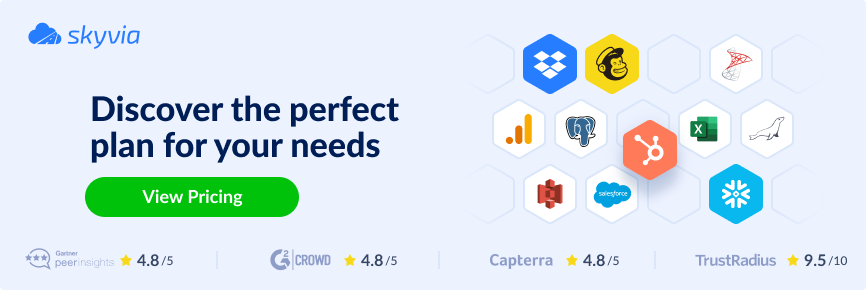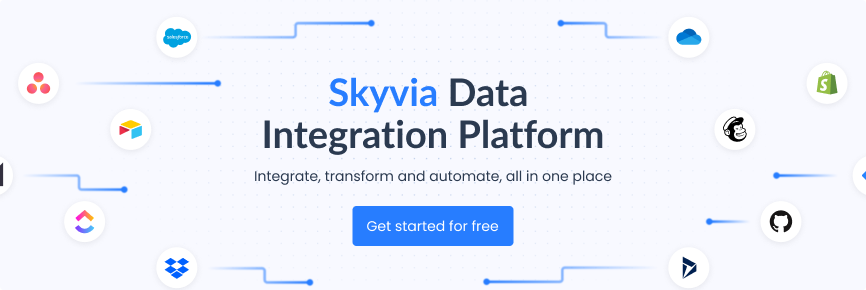Picture this: A growing e-commerce company struggles to keep up with rising demand. Their marketing team runs campaigns on one platform, customer data sits in a CRM, and financial records are locked in another system. The result? Every morning, employees spend hours manually transferring information between systems — a process that is prone to errors, slows down decision-making, and creates confusion across departments. As the business grows, the problem intensifies, with data silos becoming more entrenched, and the manual work piling up.
Does this sound familiar? If you’ve ever worked in a company where systems aren’t integrated, you know the toll it takes on productivity. The solution to this problem? Data integration.
In this article, we’ll dive into the top benefits of data integration and explore how businesses, big or small, can transform their operations and improve their bottom line. If you’re looking to make smarter decisions and boost productivity, the key might just be integrating. Let’s explore how.
Table of Contents
- Why Data Integration Is Crucial for Business Success in 2025
- Key Benefits of Data Integration
- Best Practices for Implementing Data Integration
- Key Factors to Consider When Choosing Data Integration Tools
- Popular Data Integration Tools for Businesses in 2025
- Real-World Case Studies: Data Integration in Action
- Conclusion
Why Data Integration Is Crucial for Business Success in 2025
In 2025, data is not the new oil; it’s the new currency.
Every business — whether a startup or an established enterprise — relies on vast amounts of documents to make informed decisions, optimize operations, and deliver personalized customer experiences. But here’s the catch: this information is often siloed across various systems, platforms, and departments, making it difficult to gain a unified view. This is where data integration comes in.
Simply put, data integration is the process of connecting disparate sources and systems to create a single, cohesive framework. By breaking down silos and ensuring smooth data flow, integration enables businesses to unlock the full potential of their information. For companies looking to stay competitive, having an efficient ecosystem is no longer optional — it’s a necessity. So, what are the benefits of data integration? Let’s dive into how it can drive business success.
Key Benefits of Data Integration
Integrated data is no longer just a nice-to-have — it’s a necessity. When your services are seamlessly connected, it unlocks new opportunities for efficiency and a competitive edge. Let’s dive into how to drive impactful change in your company.
1. Enhanced Decision-Making
When data is siloed across different departments and platforms, making informed decisions becomes a guessing game. You need to have a unified, real-time view of all your information, whether it’s from sales, marketing, customer service, or finance. This consolidated view empowers decision-makers with accurate, up-to-date insights, helping them make quicker and more informed choices.
In fact, businesses with well-integrated data systems report significantly improved processes, resulting in more effective strategies and better business outcomes.
2. Streamlined Operations and Increased Efficiency
Data integration eliminates the tedious, error-prone task of manually transferring information between systems. By automating these processes, businesses can:
- streamline operations
- reduce human error
- free up valuable time
This means your team spends less time on data wrangling and more time on high-value tasks, like strategic planning or customer engagement. As a result, overall operational efficiency improves, leading to cost savings and faster response times. Integrating is not just about improving how you manage information — it’s about fundamentally transforming how your business operates.
3. Better Data Quality and Accuracy
Automation plays a key role in enhancing consistency and reducing human errors. By streamlining the flow of data and enforcing standardized formats, businesses ensure that their documents remain accurate and reliable. This improvement leads to a higher level of trust in business insights.
4. Cost Savings and ROI
Redundant processes and manual data handling directly translate into operational cost savings. By automating data flows, businesses can:
- free up valuable resources
- cut down on inefficiencies
- reduce the risk of errors that could lead to costly mistakes
Moreover, integrated systems allow quicker data-driven decisions, driving better ROI as businesses can optimize operations and capitalize on new opportunities more effectively.
5. Scalable Solutions for Future Growth
As businesses grow, so do their needs. The beauty of a robust solution is that it scales effortlessly with your business. With centralized data, you can handle increasing volumes and complexities without worrying about the need for constant upgrades. Whether expanding into new markets or adding new sources, integrated systems ensure that your infrastructure can grow alongside your ambitions.
6. Enhanced Customer Insights and Personalization
Unified data provides a clearer, 360-degree view of your customers. By integrating information from various touchpoints, businesses gain deeper insights into customer behavior, preferences, and needs. This allows for more targeted marketing, personalized experiences, and stronger customer relationships. The result? A more engaged and loyal customer base that feels understood and valued.
7. Improved Collaboration Across Departments
Data integration bridges the gap between departments, fostering seamless communication and collaboration. When everyone has access to the same set of data, teams — from sales to marketing, finance to customer support — can work together more efficiently. This interconnectedness leads to faster responses to market changes and a more cohesive organizational structure. In short, it eliminates the barriers that often slow down cross-functional collaboration.
Best Practices for Implementing Data Integration
Evaluate Your Data Sources
Before jumping into the integration process, step back and evaluate your services. Understand where your data is coming from and how it’s structured. Whether it’s CRM systems, marketing platforms, or financial tools, having a clear picture of your data landscape will help you identify potential challenges and gaps in your workflow. This step is crucial for setting the stage for a smooth integration, ensuring that you bring the correct data into your system.
Choose the Right Tool for Your Business
Choosing the proper integration tool is a game-changer. Different businesses have different needs, so what works for one company might not work for another. Whether you need a no-code solution for ease of use or a more robust, customizable platform for complex data tasks, the tool should align with your team’s skills, budget, and future goals. Consider scalability, ease of integration, and how well the platform supports your existing systems.
Ensure Data Quality from the Start
Workflows can’t be effective without ensuring data quality from the get-go. Garbage in means garbage out. Prioritize data cleansing and validation processes early in the integration to avoid poor decision-making based on inaccurate or incomplete information. The goal is not just to integrate systems, but to integrate clean, reliable data that adds value across your business operations.
Plan for Scalability
Plan from the start by choosing integration tools and processes that can handle increased data volumes and evolving requirements. A scalable integration setup will not only support your business’s current needs but also allow you to adapt as new systems and platforms come into play. The more future-proof your integration, the easier it will be to handle growth without disrupting business operations.
Key Factors to Consider When Choosing Data Integration Tools
1. Integration with Existing Tools
When selecting a new service, the first thing to evaluate is how well it integrates with the systems you’re already using. Whether it’s CRM software, marketing platforms, or ERP systems, seamless integration ensures that your new tool doesn’t disrupt existing workflows.
Compatibility is key — make sure the tool can pull data from all your platforms and sync it effortlessly without creating additional silos. A tool that doesn’t play well with your tech stack could lead to more manual work and data inconsistencies, which defeats the purpose of integrating in the first place.
2. Ease of Use and Customization
Next, think about usability. A tool might have all the features you need, but if your team struggles with its interface or can’t customize it to suit your processes, you’ll run into problems. Look for a solution that balances ease of use with flexibility. A no-code platform like Skyvia might be ideal for teams without technical expertise, but it also provides features for complex integration needs. The right balance will empower your team to manage integrations without constant external support.
3. Scalability and Support for Big Data
Your tool stack should grow as your business does. As you scale, the volume, variety, and complexity will also increase. Choose a platform built to handle big data without compromising speed or accuracy. Scalability is particularly crucial if you plan to expand your data ecosystem or integrate additional sources in the future. Ensure the tool supports large-scale operations and seamlessly handles larger workloads.
4. Cost and Licensing Models
Cost is, of course, a major factor. But don’t just focus on the upfront costs. Consider the licensing model and any additional expenses down the line. Some tools charge based on data volume, while others charge per user or task. Make sure you understand how pricing scales with your needs and whether the tool’s total cost fits within your budget.
Additionally, consider whether the value and functionality of the tool align with its price tag. Investing in a solution that offers scalability and flexibility can save you from having to switch tools down the line.
Popular Data Integration Tools for Businesses in 2025
Before diving into the details of the most popular tools, let’s take a quick look at a comparison table to get an overview of their features and capabilities.
| Platform | G2 Rating | Best For | Pricing |
|---|---|---|---|
| Skyvia | 4.8 out of 5 | Businesses of any size and any industry. | Free plan available. Paid plans start at $79/month. |
| Talend | 4.0 out of 5 | Telecommunication, Government, and Healthcare companies. | The cost is discussed with their Sales team based on the four pricing plans. |
| Fivetran | 4.4 out of 5 | Teams focused on replication and ELT, not custom logic or scripting. | Free plan available. Starter plan starts at ~$300/month. |
| Airbyte | 4.4 out of 5 | Companies with cloud infrastructure looking for open-source alternatives. | The open-source version is free. The cloud version has volume-based pricing. |
| Hevo Data | 4.6 out of 5 | Startups and growing companies. | Event volume-based pricing model. Starter plan begins at $239/month. |
| Informatica | 4.3 out of 5 | Insurance, Healthcare, and Education companies. | Volume-based pricing model. |
1. Skyvia
Skyvia is a no-code, cloud-based data integration platform that simplifies ETL and ELT processes, providing over 200 connectors to cloud apps, databases, and file storage platforms. With its intuitive drag-and-drop interface, it makes automation, data migration, and sync tasks easy for both technical and non-technical users. Whether you’re looking to automate data pipelines or unify your tech stack, Skyvia offers scalability and flexibility for any businesses.
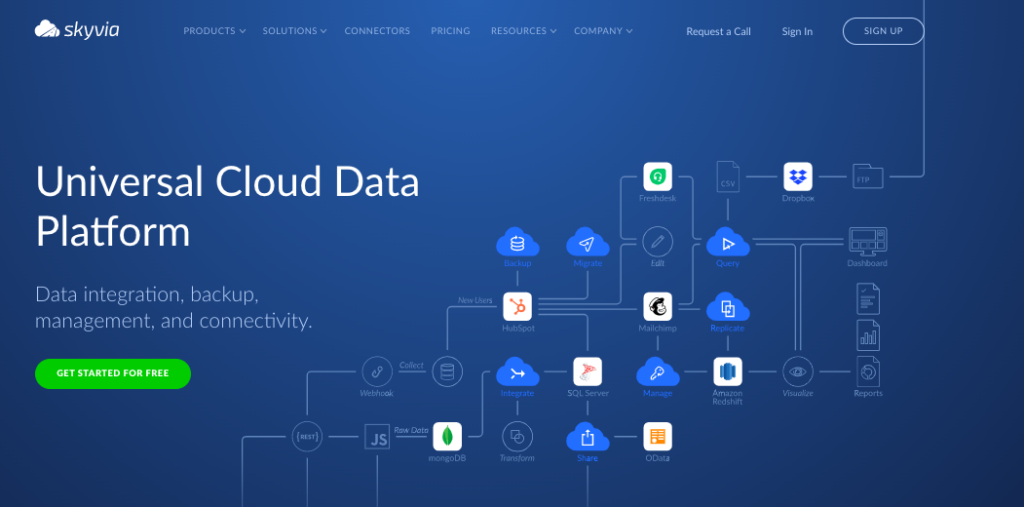
Pros
- No-code interface, ideal for non-technical users
- Supports a wide variety of integrations
- Flexible pricing and robust scheduling options
Cons
- Lacks support for real-time data syncing
- No on-premise deployment option
Reviews
G2 rating: 4.8 out of 5.0
Best for
Skyvia is an intuitive, no-code platform that fits businesses of all sizes across various industries. With flexible subscription plans, it offers powerful data integration capabilities without requiring complex setups or heavy IT resources.
Key Benefits of Skyvia
- Ease of Use: Skyvia’s browser-based interface ensures that no extra installations are needed, allowing teams to get started quickly. With helpful tips and in-app guidance, users can easily navigate through the platform.
- No Coding: Whether you’re creating complex integration scenarios or building data pipelines, Skyvia simplifies the process with its user-friendly visual wizard. No programming knowledge is necessary, which makes it accessible to non-technical users while still offering powerful functionality.
- Connectivity: Over 200 pre-built connectors, enabling seamless integration across a wide range of data sources, including databases, cloud applications, storage systems, and data warehouses.
- Error Logging: When issues arise during integration, there are detailed error descriptions, helping users quickly identify and resolve problems.
- Freemium Plan: The platform offers a free, fully-featured plan, allowing users to try everything without any upfront costs. While the free version includes unlimited access to connectors, there are limits on scheduled integrations and data processing volumes.
- Scalable Pricing: Skyvia’s volume- and feature-based pricing ensures that businesses only pay for what they need, with the flexibility to scale as data integration needs grow. Whether you’re a startup or a large enterprise, there’s a plan to suit your requirements.
2. Talend
Talend is an open-source ETL tool with a strong focus on both cloud and on-premises integration. Built on Java and Eclipse, it supports complex workflows, transforming data with its visual drag-and-drop UI. While it’s highly customizable and works well in big data environments, Talend requires technical expertise, particularly when creating custom integrations.
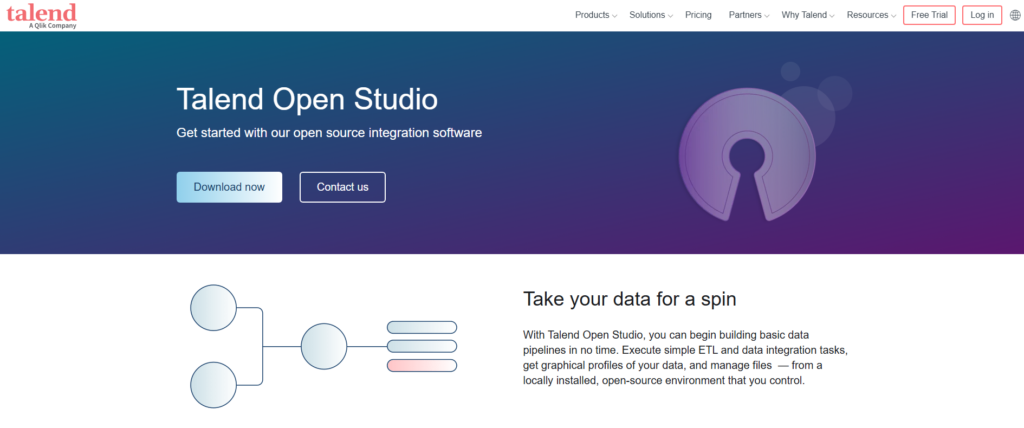
Pros
- Open-source and highly customizable
- Strong support for big data tools like Hadoop
- Advanced error handling and logging
Cons
- Steep learning curve for beginners
- Not beginner-friendly
- UI performance can be slow for large data sets
Reviews
G2 rating: 4.0 out of 5.0
Best for
Talend Data Integration is particularly valuable for companies in industries like Telecommunications, Government, Healthcare, and Finance. In Healthcare, it helps systematize patient data from clinical trials for accurate analysis. For Government organizations, Talend ensures compliance with GDPR while managing data from various public apps. It’s an ideal solution for any industry needing efficient, scalable data integration and regulatory compliance.
3. Fivetran
Fivetran is a fully managed, cloud-native ELT platform designed for high-volume data replication. It automates data extraction from over 500 sources, including SaaS tools and databases, and loads it directly into your data warehouse. Fivetran’s “set-it-and-forget-it” approach makes it ideal for teams focusing on scaling with minimal maintenance.
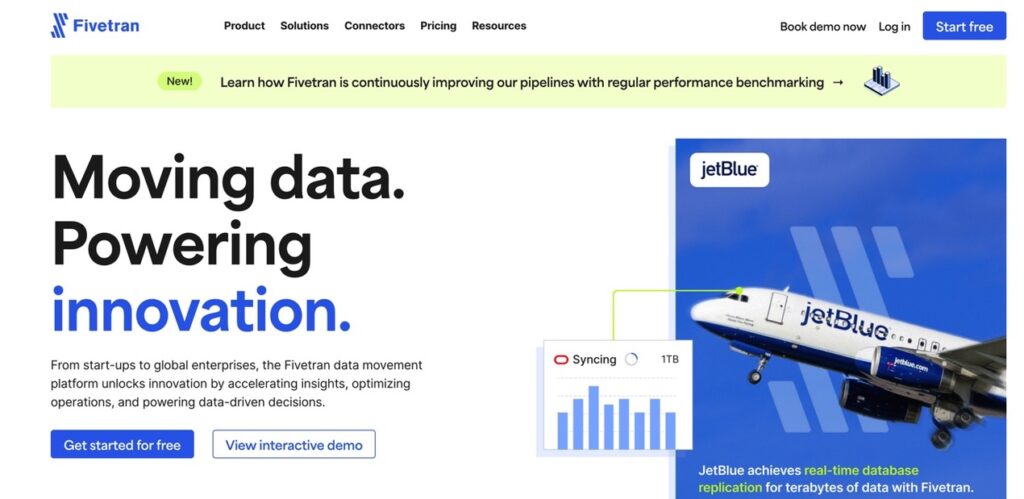
Pros
- Zero-maintenance setup with automatic schema updates
- Fast setup and high scalability
- Optimized for ELT workflows
Cons
- Lacks pre-load transformations, only post-load
- Expensive at scale
- Limited custom pipeline flexibility
Reviews
G2 Rating: 4.4 out of 5
Best for
Ideal for data teams and analysts who need fast, reliable access to raw data for reporting or modeling. It’s a great fit for companies using modern data stacks like dbt, Snowflake, and Fivetran. Additionally, it works well for organizations with growing connector needs and limited engineering capacity. Perfect for teams focused on replication and ELT, rather than custom logic or scripting.
4. Airbyte
Airbyte is an open-source ETL tool that focuses on scalability and extensibility, allowing teams to centralize and sync data from various sources to destinations like MySQL, BigQuery, and Redshift. Its modular architecture is ideal for data engineers who prefer building and customizing their own connectors. Airbyte can be deployed locally or in the cloud, offering flexibility without vendor lock-in.
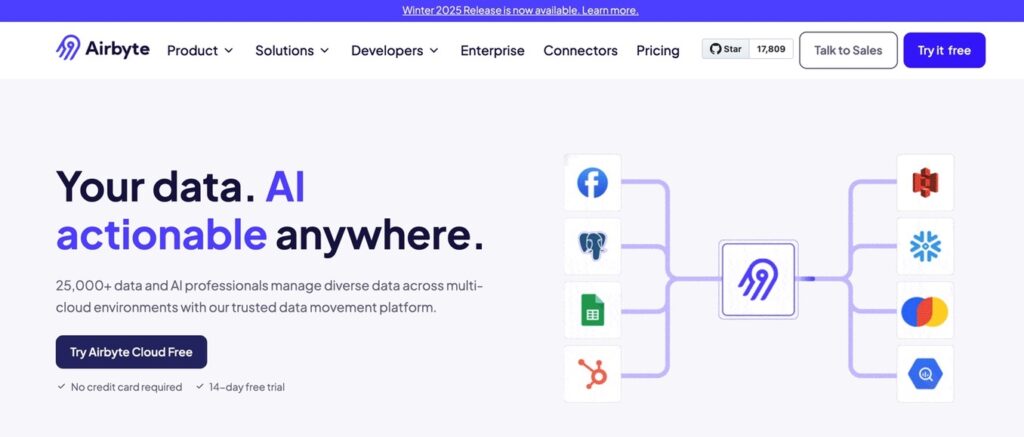
Pros
- Open-source with a growing library of pre-built connectors
- Easily deployable locally or in your cloud
- REST API and CLI support for automation
Cons
- Requires some technical knowledge
- Some connectors are unstable or still in development
- Limited built-in scheduling features
Reviews
G2 Rating: 4.4 out of 5
Best For
Perfect for data teams and engineers who need to build or customize their own connectors. It’s also well-suited for companies with cloud infrastructure seeking self-hosted or open-source alternatives. Additionally, it excels in use cases where ELT is preferred over traditional ETL, such as scenarios where transformations are done in the database after the data is loaded.
5. Hevo Data
Hevo Data is a cloud-native, no-code ETL platform designed to streamline the movement of data in real-time from over 150 sources to popular data warehouses like Snowflake, BigQuery, Redshift, and MySQL. The platform prioritizes automation and ease of use, enabling teams to sync and transform data without writing code. With its intuitive UI, real-time streaming capabilities, and built-in data quality checks, Hevo is ideal for operational analytics and business intelligence applications.
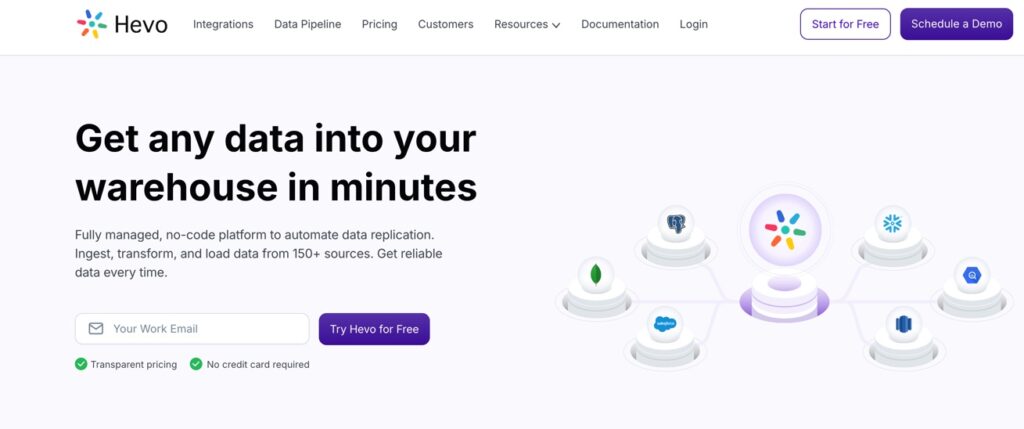
Pros
- Supports both batch and real-time streaming ETL
- Automatic schema mapping and transformation options
- Strong monitoring and alerting for pipeline health
- Built-in data quality checks for reliable analytics
Cons
- Limited flexibility for highly customized transformations
- Expensive at scale with increasing data volume
- No on-premise deployment; cloud-only
Reviews
G2 Rating: 4.6 out of 5
Best for
Ideal for startups and growing businesses that need fast and reliable data syncing with cloud warehouses. It’s also perfect for operations and marketing teams looking to enable self-service analytics with minimal IT involvement. Additionally, data engineers and analysts seeking a robust streaming ETL solution with strong automation and real-time alerting will find it highly beneficial.
6. Informatica
Informatica offers a comprehensive suite of tools for data management, focusing on the Intelligent Cloud Data Management platform for building ETL and ELT processes that handle large data volumes. With its pay-as-you-go pricing model, businesses can scale operations efficiently according to their current needs. The platform simplifies the developer’s role by automating routine tasks, scheduling integrations, and providing clear visibility into workloads and pipelines. This solution is well-suited for industries like insurance, healthcare, life sciences, and financial services, offering businesses the flexibility to adapt quickly in response to changing demands.
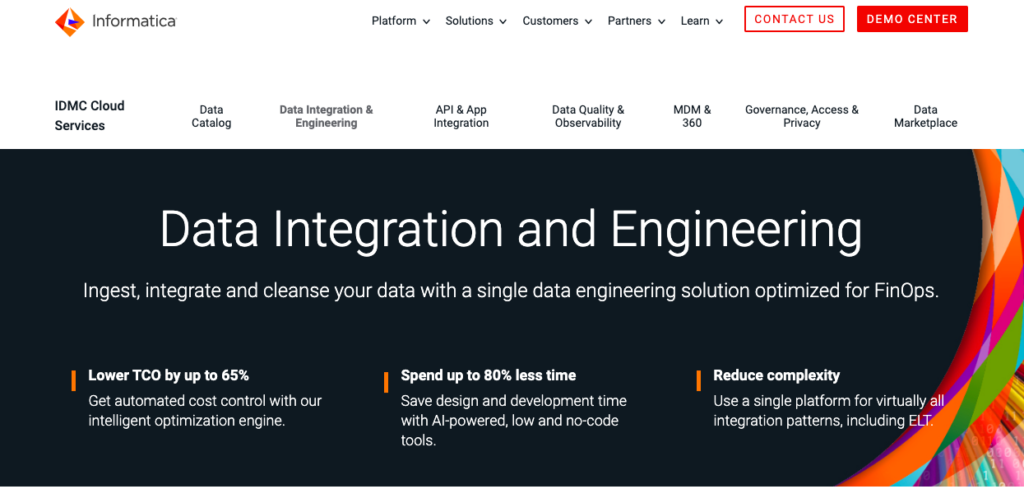
Pros
- Scalable for high data volumes
- Automated routine tasks and integration scheduling
- Strong support for compliance and governance
- Advanced encryption for secure data transfer
Cons
- High pricing compared to similar tools
- Lack of detailed error messages for troubleshooting
- Occasional performance issues
Reviews
G2 rating: 4.3 out of 5
Best for
Informatica’s Intelligent Cloud Data Management is ideal for industries like Insurance, Healthcare, Life Sciences, and Financial Services. It simplifies digital transformation by unifying the entire value chain in the data cloud, making it particularly valuable for industries that require fast and efficient data integration. For example, in Life Sciences, it enables quick responses to public health emergencies by consolidating research data from multiple sources, providing a complete and actionable overview in real-time.
Real-World Case Studies: Data Integration in Action
Let’s dive into a practical use case from NISO, which transformed its financial operations by automating data flows with Skyvia.
NISO faced a significant challenge: they needed to paint a complete picture of their customers’ financial aspects. The process of manually extracting data from MySQL, transferring it to Excel spreadsheets, and then uploading it to QuickBooks Online became increasingly cumbersome as the company grew. This time-consuming process was holding back their ability to scale and automate financial operations effectively.
The manual method wasn’t cutting it anymore. What NISO needed was a way to streamline and automate the entire data flow. This is where Skyvia came in.
“We needed a way to consolidate and integrate the information from various data sources and systems, and Skyvia fit that gap very precisely,” said Rodrigo Fritis, CEO at NISO.
To dive deeper into how NISO overcame this challenge and achieved its goal of streamlined, automated data integration, watch the full video interview with CEO Rodrigo Fritis. Hear firsthand how Skyvia helped the company to unify its data systems.
Conclusion
Data integration is no longer just a luxury — it’s a necessity for staying competitive. By streamlining your data workflows, you can significantly enhance decision-making and improve operational efficiency in your business. The key benefits of data integration — ranging from better data quality and cost savings to improved collaboration and scalability — are essential for modern businesses looking to thrive in a data-driven world.
In this article, we’ve explored the pros and cons of six different data integration tools and platforms, highlighting their strengths and limitations to help you make an informed decision. However, the best way to determine which solution truly meets your needs is by trying it out live. Whether through a demo or a free trial, testing the tool in your environment is the most effective way to see how it fits into the data workflows.
If you’re ready to explore data integration further, try Skyvia’s capabilities today! You can start with a free trial and discover how easily it can streamline your data processes.
F.A.Q. for the Benefits of Data Integration
What is the primary purpose of data integration?
The primary purpose of data integration is to consolidate data from various sources, making it accessible in a central location for analysis. It eliminates data silos and ensures that data flows seamlessly between systems.
What are the benefits of system integration?
- Improved Efficiency: Businesses reduce manual work and speed up workflows.
- Better Decision-Making: Integrated data provides a holistic view of business operations.
- Cost Savings: Reduces the need for redundant data processing and lowers operational costs.
- Scalability: Businesses can easily scale operations as data volumes grow without sacrificing performance.
What are the challenges of data integration?
Some common challenges include managing data quality, handling large data volumes, ensuring security and compliance, and integrating data from disparate sources with different formats.
What industries can benefit from data integration?
Data integration is valuable across industries, including finance, healthcare, retail, marketing, and manufacturing. It helps organizations across sectors streamline operations, improve data accuracy, and make informed decisions.
